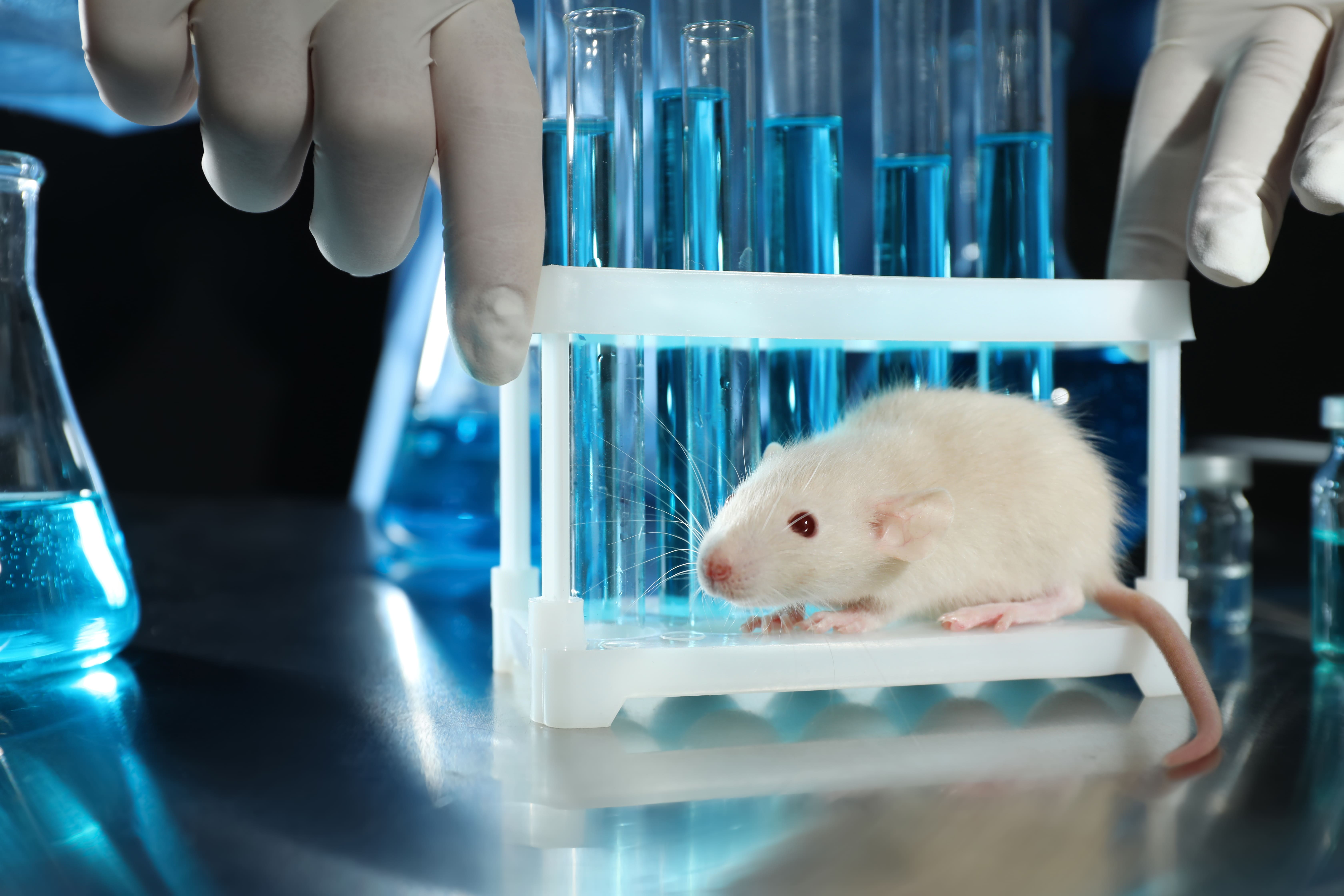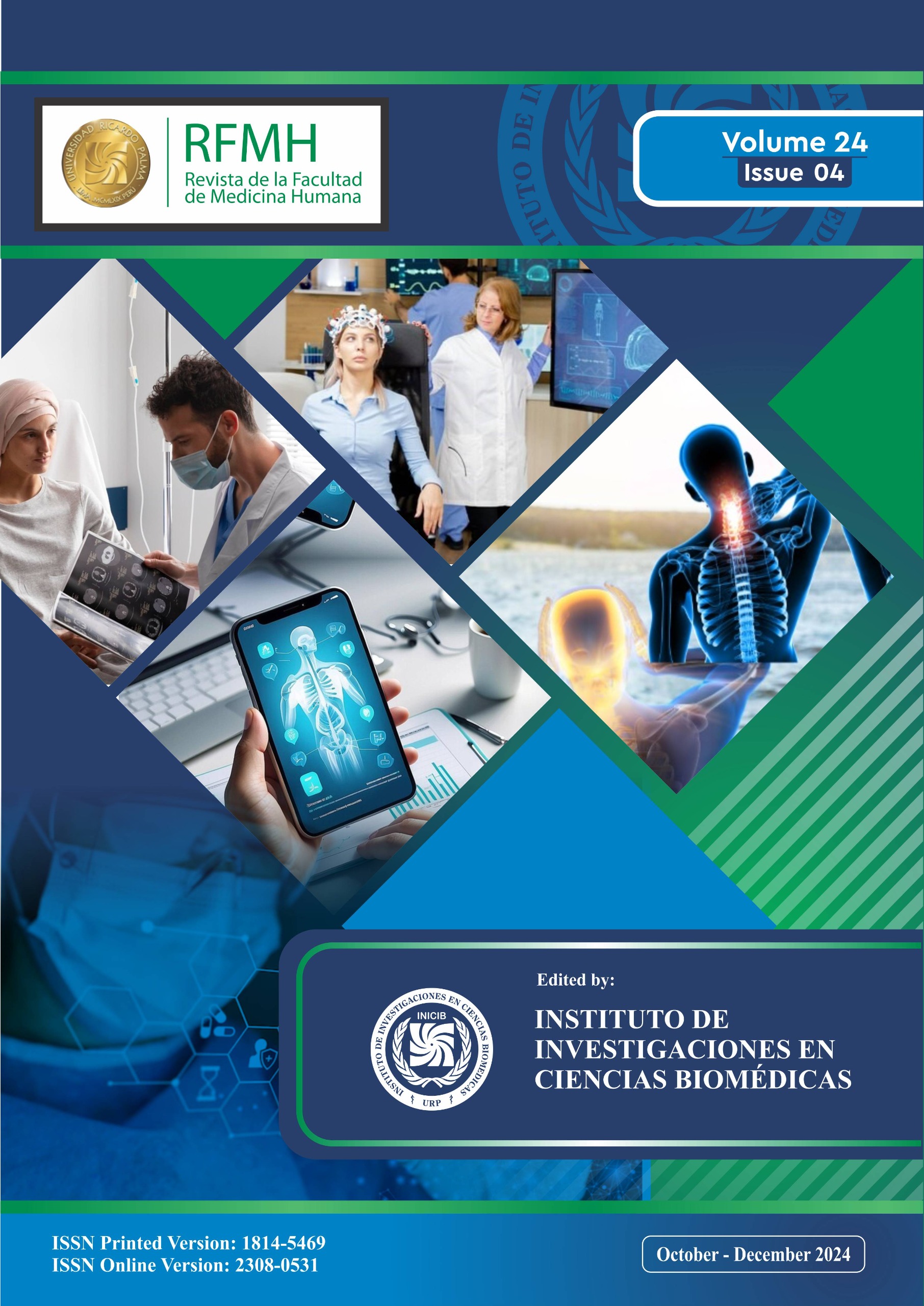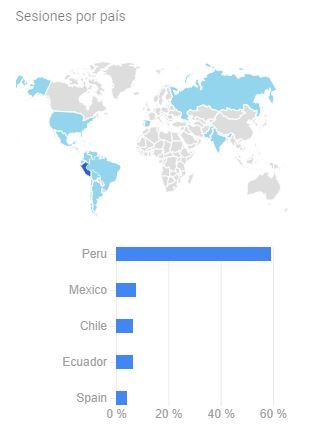MURINE MODELS FOR THE STUDY OF TRIPLE NEGATIVE BREAST CANCER
MODELOS MURINOS PARA EL ESTUDIO DE CÁNCER DE MAMA TRIPLE NEGATIVO
DOI:
https://doi.org/10.25176/RFMH.v23i4.6206Keywords:
murin model, triple negative breast cancer, induction, antitumor therapyAbstract
ABSTRACT
The study of different variables, such as pathogenesis, inflammatory profile, identification of therapeutic targets, efficacy of treatments in murine models has proven to be one of the most practical for the preclinical study of triple negative breast cancer (TNBC), the most aggressive subtype of cancer, with limited application of treatments and low survival rate. However, it must be recognized that there are other minors in which the induction of TNBC is being standardized. This review encompasses the different induction methods that have allowed the development of TNBC and the most relevant therapeutic applications by which murine models with TNBC were developed.
Downloads
References
Sung H, Ferlay J, Siegel RL, Laversanne M, Soerjomataram I, Jemal A, et al. Global Cancer Statistics 2020: GLOBOCAN Estimates of Incidence and Mortality Worldwide for 36 Cancers in 185 Countries. CA Cancer J Clin. mayo de 2021;71(3):209-49.
Soerjomataram I, Bray F. Planning for tomorrow: global cancer incidence and the role of prevention 2020-2070. Nat Rev Clin Oncol. octubre de 2021;18(10):663-72.
Vidoni C, Vallino L, Ferraresi A, Secomandi E, Salwa A, Chinthakindi M, et al. Epigenetic control of autophagy in women’s tumors: role of non-coding RNAs. J Cancer Metastasis Treat [Internet]. 1 de enero de 2021 [citado 28 de noviembre de 2023];2021. Disponible en: https://iris.uniupo.it/handle/11579/121513
Yersal O, Barutca S. Biological subtypes of breast cancer: Prognostic and therapeutic implications. World J Clin Oncol. 10 de agosto de 2014;5(3):412-24.
Singhal SS, Garg R, Mohanty A, Garg P, Ramisetty SK, Mirzapoiazova T, et al. Recent Advancement in Breast Cancer Research: Insights from Model Organisms—Mouse Models to Zebrafish. Cancers. enero de 2023;15(11):2961.
Gupta A, Jain GK, Raghubir R. A time course study for the development of an immunocompromised wound model, using hydrocortisone. J Pharmacol Toxicol Methods. agosto de 1999;41(4):183-7.
Noto FK, Sangodkar J, Adedeji BT, Moody S, McClain CB, Tong M, et al. The SRG rat, a Sprague-Dawley Rag2/Il2rg double-knockout validated for human tumor oncology studies. PLOS ONE. 7 de octubre de 2020;15(10):e0240169.
Yang Y, Yang HH, Hu Y, Watson PH, Liu H, Geiger TR, et al. Immunocompetent mouse allograft models for development of therapies to target breast cancer metastasis. Oncotarget. 9 de mayo de 2017;8(19):30621-43.
Zeng L, Li W, Chen CS. Breast cancer animal models and applications. Zool Res. 18 de septiembre de 2020;41(5):477-94.
Puchalapalli M, Zeng X, Mu L, Anderson A, Glickman LH, Zhang M, et al. NSG Mice Provide a Better Spontaneous Model of Breast Cancer Metastasis than Athymic (Nude) Mice. PLOS ONE. 23 de septiembre de 2016;11(9):e0163521.
Korangath P, Barnett JD, Sharma A, Henderson ET, Stewart J, Yu SH, et al. Nanoparticle interactions with immune cells dominate tumor retention and induce T cell–mediated tumor suppression in models of breast cancer. Sci Adv. 2020;6(13).
Li Y, Hively WP, Varmus HE. Use of MMTV-Wnt-1 transgenic mice for studying the genetic basis of breast cancer. Oncogene. 21 de febrero de 2000;19(8):1002-9.
Ding Q, Gan L. Conditional control of gene expression in the mouse retina. Methods Mol Biol Clifton NJ. 2012;884:3-15.
Stambolic V, Tsao MS, Macpherson D, Suzuki A, Chapman WB, Mak TW. High incidence of breast and endometrial neoplasia resembling human Cowden syndrome in pten+/- mice. Cancer Res. 1 de julio de 2000;60(13):3605-11.
Liu P, Cheng H, Santiago S, Raeder M, Zhang F, Isabella A, et al. Oncogenic PIK3CA-driven mammary tumors frequently recur via PI3K pathway-dependent and PI3K pathway-independent mechanisms. Nat Med. 7 de agosto de 2011;17(9):1116-20.
Xu X, Wagner KU, Larson D, Weaver Z, Li C, Ried T, et al. Conditional mutation of Brca1 in mammary epithelial cells results in blunted ductal morphogenesis and tumour formation. Nat Genet. mayo de 1999;22(1):37-43.
Arzi L, Farahi A, Jafarzadeh N, Riazi G, Sadeghizadeh M, Hoshyar R. Inhibitory Effect of Crocin on Metastasis of Triple-Negative Breast Cancer by Interfering with Wnt/β-Catenin Pathway in Murine Model. DNA Cell Biol. diciembre de 2018;37(12):1068-75.
Kaur P, Nagaraja GM, Zheng H, Gizachew D, Galukande M, Krishnan S, et al. A mouse model for triple-negative breast cancer tumor-initiating cells (TNBC-TICs) exhibits similar aggressive phenotype to the human disease. BMC Cancer. 27 de marzo de 2012;12:120.
Zhang Q, Le K, Xu M, Zhou J, Xiao Y, Yang W, et al. Combined MEK inhibition and tumor-associated macrophages depletion suppresses tumor growth in a triple-negative breast cancer mouse model. Int Immunopharmacol. 1 de noviembre de 2019;76:105864.
Ahn RW, Chen F, Chen H, Stern ST, Clogston JD, Patri AK, et al. A novel nanoparticulate formulation of arsenic trioxide with enhanced therapeutic efficacy in a murine model of breast cancer. Clin Cancer Res Off J Am Assoc Cancer Res. 15 de julio de 2010;16(14):3607-17.
Boix-Montesinos P, Soriano-Teruel PM, Armiñán A, Orzáez M, Vicent MJ. The past, present, and future of breast cancer models for nanomedicine development. Adv Drug Deliv Rev. 1 de junio de 2021;173:306-30.
Steenbrugge J, Breyne K, Demeyere K, De Wever O, Sanders NN, Van Den Broeck W, et al. Anti-inflammatory signaling by mammary tumor cells mediates prometastatic macrophage polarization in an innovative intraductal mouse model for triple-negative breast cancer. J Exp Clin Cancer Res. 15 de agosto de 2018;37(1):191.
García-Castillo V, López-Urrutia E, Villanueva-Sánchez O, Ávila-Rodríguez MÁ, Zentella-Dehesa A, Cortés-González C, et al. Targeting Metabolic Remodeling in Triple Negative Breast Cancer in a Murine Model. J Cancer. 13 de enero de 2017;8(2):178-89.
Malekian S, Rahmati M, Sari S, Kazemimanesh M, Kheirbakhsh R, Muhammadnejad A, et al. Expression of Diverse Angiogenesis Factor in Different Stages of the 4T1 Tumor as a Mouse Model of Triple-Negative Breast Cancer. Adv Pharm Bull. junio de 2020;10(2):323-8.
Arroyo‐Crespo JJ, Armiñán A, Charbonnier D, Deladriere C, Palomino‐Schätzlein M, Lamas‐Domingo R, et al. Characterization of triple‐negative breast cancer preclinical models provides functional evidence of metastatic progression. Int J Cancer. 15 de octubre de 2019;145(8):2267-81.
Okano M, Oshi M, Butash A, Okano I, Saito K, Kawaguchi T, et al. Orthotopic Implantation Achieves Better Engraftment and Faster Growth Than Subcutaneous Implantation in Breast Cancer Patient-Derived Xenografts. J Mammary Gland Biol Neoplasia. marzo de 2020;25(1):27-36.
Zamberi NR, Abu N, Mohamed NE, Nordin N, Keong YS, Beh BK, et al. The Antimetastatic and Antiangiogenesis Effects of Kefir Water on Murine Breast Cancer Cells. Integr Cancer Ther. diciembre de 2016;15(4):NP53-66.
Ghosh A, Sarkar S, Banerjee S, Behbod F, Tawfik O, McGregor D, et al. MIND model for triple-negative breast cancer in syngeneic mice for quick and sequential progression analysis of lung metastasis. PloS One. 2018;13(5):e0198143.
Bouchard G, Therriault H, Geha S, Bérubé-Lauzière Y, Bujold R, Saucier C, et al. Stimulation of triple negative breast cancer cell migration and metastases formation is prevented by chloroquine in a pre-irradiated mouse model. BMC Cancer. 10 de junio de 2016;16(1):361.
Peeney D, Jensen SM, Castro NP, Kumar S, Noonan S, Handler C, et al. TIMP-2 suppresses tumor growth and metastasis in murine model of triple-negative breast cancer. Carcinogenesis. 14 de mayo de 2020;41(3):313-25.
Costa E, Ferreira-Gonçalves T, Chasqueira G, Cabrita AS, Figueiredo IV, Reis CP. Experimental Models as Refined Translational Tools for Breast Cancer Research. Sci Pharm. septiembre de 2020;88(3):32.
Nofiele JT, Cheng HLM. Establishment of a Lung Metastatic Breast Tumor Xenograft Model in Nude Rats. PLOS ONE. 16 de mayo de 2014;9(5):e97950.
Souto EP, Dobrolecki LE, Villanueva H, Sikora AG, Lewis MT. In Vivo Modeling of Human Breast Cancer Using Cell Line and Patient-Derived Xenografts. J Mammary Gland Biol Neoplasia. junio de 2022;27(2):211-30.
Echeverria GV, Cai S, Tu Y, Shao J, Powell E, Redwood AB, et al. Predictors of success in establishing orthotopic patient-derived xenograft models of triple negative breast cancer. Npj Breast Cancer. 10 de enero de 2023;9(1):1-9.
Kassayová M, Bobrov N, Strojný L, Orendáš P, Demečková V, Jendželovský R, et al. Anticancer and Immunomodulatory Effects of Lactobacillus plantarum LS/07, Inulin and Melatonin in NMU-induced Rat Model of Breast Cancer. Anticancer Res. junio de 2016;36(6):2719-28.
Liu Y, Hu Y, Xue J, Li J, Yi J, Bu J, et al. Advances in immunotherapy for triple-negative breast cancer. Mol Cancer. 2 de septiembre de 2023;22(1):145.
Shull JD, Dennison KL, Chack AC, Trentham-Dietz A. Rat models of 17β-estradiol-induced mammary cancer reveal novel insights into breast cancer etiology and prevention. Physiol Genomics. 1 de marzo de 2018;50(3):215-34.
Ruhlen RL, Willbrand DM, Besch-Williford CL, Ma L, Shull JD, Sauter ER. Tamoxifen induces regression of estradiol-induced mammary cancer in the ACI.COP-Ept2 rat model. Breast Cancer Res Treat. octubre de 2009;117(3):517-24.
Russo IH, Russo J. Mammary gland neoplasia in long-term rodent studies. Environ Health Perspect. septiembre de 1996;104(9):938-67.
Hernandez R, Grudzinski JJ, Aluicio-Sarduy E, Massey CF, Pinchuk AN, Bitton AN, et al. 177Lu-NM600 Targeted Radionuclide Therapy Extends Survival in Syngeneic Murine Models of Triple-Negative Breast Cancer. J Nucl Med. 1 de agosto de 2020;61(8):1187-94.
Zhou ZR, Wang XY, Yu XL, Mei X, Chen XX, Hu QC, et al. Building radiation-resistant model in triple-negative breast cancer to screen radioresistance-related molecular markers. Ann Transl Med. febrero de 2020;8(4):108.
Bianchini G, Balko JM, Mayer IA, Sanders ME, Gianni L. Triple-negative breast cancer: challenges and opportunities of a heterogeneous disease. Nat Rev Clin Oncol. noviembre de 2016;13(11):674-90.
Shafee N, Smith CR, Wei S, Kim Y, Mills GB, Hortobagyi GN, et al. Cancer stem cells contribute to cisplatin resistance in Brca1/p53-mediated mouse mammary tumors. Cancer Res. 1 de mayo de 2008;68(9):3243-50.
To C, Kim EH, Royce DB, Williams CR, Collins RM, Risingsong R, et al. The PARP inhibitors, veliparib and olaparib, are effective chemopreventive agents for delaying mammary tumor development in BRCA1-deficient mice. Cancer Prev Res Phila Pa. julio de 2014;7(7):698-707.
Santana-Krímskaya SE, Franco-Molina MA, Zárate-Triviño DG, Prado-García H, Zapata-Benavides P, Torres-del-Muro F, et al. IMMUNEPOTENT CRP plus doxorubicin/cyclophosphamide chemotherapy remodel the tumor microenvironment in an air pouch triple-negative breast cancer murine model. Biomed Pharmacother. 1 de junio de 2020;126:110062.
Qiu X, Qu Y, Guo B, Zheng H, Meng F, Zhong Z. Micellar paclitaxel boosts ICD and chemo-immunotherapy of metastatic triple negative breast cancer. J Controlled Release. 1 de enero de 2022;341:498-510.
Silva CR, de Almeida Salvego C, Rostelato ME, Zeituni CA, Ribeiro MS. Photobiomodulation therapy combined with radiotherapy in the treatment of triple-negative breast cancer-bearing mice. J Photochem Photobiol B. 1 de julio de 2021;220:112215.
Zhang R, Yang Y, Dong W, Lin M, He J, Zhang X, et al. D-mannose facilitates immunotherapy and radiotherapy of triple-negative breast cancer via degradation of PD-L1. Proc Natl Acad Sci. 22 de febrero de 2022;119(8):e2114851119.
Anti-tumor responses to hypofractionated radiation in mice grafted with triple negative breast cancer is associated with decorin induction in peritumoral muscles. Acta Biochim Biophys Sin. 14 de agosto de 2018;1150-7.
Grudzinski J, Marsh I, Titz B, Jeffery J, Longino M, Kozak K, et al. CLR 125 Auger Electrons for the Targeted Radiotherapy of Triple-Negative Breast Cancer. Cancer Biother Radiopharm. abril de 2018;33(3):87-95.
Cammarata FP, Forte GI, Broggi G, Bravatà V, Minafra L, Pisciotta P, et al. Molecular Investigation on a Triple Negative Breast Cancer Xenograft Model Exposed to Proton Beams. Int J Mol Sci. enero de 2020;21(17):6337.
Ashraf Y, Mansouri H, Laurent-Matha V, Alcaraz LB, Roger P, Guiu S, et al. Immunotherapy of triple-negative breast cancer with cathepsin D-targeting antibodies. J Immunother Cancer. 4 de febrero de 2019;7(1):29.
Kim IS, Gao Y, Welte T, Wang H, Liu J, Janghorban M, et al. Immuno-subtyping of breast cancer reveals distinct myeloid cell profiles and immunotherapy resistance mechanisms. Nat Cell Biol. septiembre de 2019;21(9):1113-26.
Pack CD, Bommireddy R, Munoz LE, Patel JM, Bozeman EN, Dey P, et al. Tumor membrane-based vaccine immunotherapy in combination with anti-CTLA-4 antibody confers protection against immune checkpoint resistant murine triple-negative breast cancer. Hum Vaccines Immunother. 1 de diciembre de 2020;16(12):3184-93.
Liu X, Hu J, Cao W, Qu H, Wang Y, Ma Z, et al. Effects of two different immunotherapies on triple negative breast cancer in animal model. Cell Immunol. 1 de julio de 2013;284(1):111-8.
Xu H, Hu M, Liu M, An S, Guan K, Wang M, et al. Nano-puerarin regulates tumor microenvironment and facilitates chemo- and immunotherapy in murine triple negative breast cancer model. Biomaterials. 1 de marzo de 2020;235:119769.
De Almeida CV, de Camargo MR, Russo E, Amedei A. Role of diet and gut microbiota on colorectal cancer immunomodulation. World J Gastroenterol. 14 de enero de 2019;25(2):151-62.
Maroof H, Hassan ZM, Mobarez AM, Mohamadabadi MA. Lactobacillus acidophilus could modulate the immune response against breast cancer in murine model. J Clin Immunol. diciembre de 2012;32(6):1353-9.
Mendoza L. Potential effect of probiotics in the treatment of breast cancer. Oncol Rev. 27 de septiembre de 2019;13(2):422.
de Moreno de LeBlanc A, Matar C, LeBlanc N, Perdigón G. Effects of milk fermented by Lactobacillus helveticusR389 on a murine breast cancer model. Breast Cancer Res. 26 de abril de 2005;7(4):R477.
Kim H, Oh R, Heo JW, Ji GE, Park MS, Kim SE. Abstract LB532: Bifidobacterium longum RAPO alleviates the risk of immune-related adverse events of anti-PD-1 immunotherapy in a mouse model of triple-negative breast cancer. Cancer Res. 15 de junio de 2022;82(12_Supplement):LB532.
Yazdi MH, Mahdavi M, Kheradmand E, Shahverdi AR. The Preventive Oral Supplementation of a Selenium Nanoparticle-enriched Probiotic Increases the Immune Response and Lifespan of 4T1 Breast Cancer Bearing Mice. Arzneimittelforschung. noviembre de 2012;62(11):525-31.
Nazari F, Jafari P, Nomanpour B, Varmira K, Raissi F. Inhibitory effects of postbiotic consisting sonication-killed Bifidobacterium bifidum on experimental triple negative breast neoplasm in mice: a preliminary study. Iran J Microbiol. octubre de 2022;14(5):689-97.
Liu C, Wu P, Zhang A, Mao X. Advances in Rodent Models for Breast Cancer Formation, Progression, and Therapeutic Testing. Front Oncol [Internet]. 2021 [citado 12 de diciembre de 2023];11. Disponible en: https://www.frontiersin.org/articles/10.3389/fonc.2021.593337
Fazio M, Ablain J, Chuan Y, Langenau DM, Zon LI. Zebrafish patient avatars in cancer biology and precision cancer therapy. Nat Rev Cancer. mayo de 2020;20(5):263-73.

Downloads
Published
How to Cite
Issue
Section
License
Copyright (c) 2024 Revista de la Facultad de Medicina Humana

This work is licensed under a Creative Commons Attribution 4.0 International License.





























